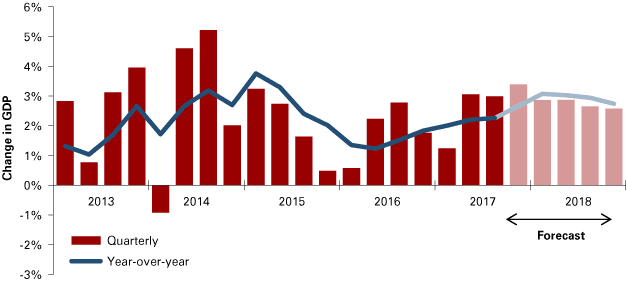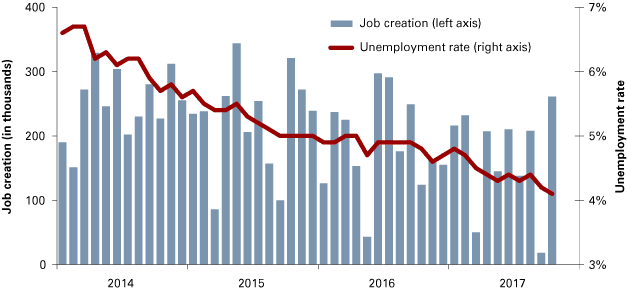U.S. outlook for 2018

Associate Professor Emeritus, Department of Economics, Indiana University Bloomington
A year ago, we expected that economic growth in 2017 would be similar to 2016, with perhaps a few improvements around the edges. That has proved to be essentially correct.
We also expected the same in the labor market. That has proved to be incorrect.
On the output side, our forecast was for 2017 growth to average slightly above 2 percent. Through three quarters, the actual number is 2.4 percent (see Figure 1).
Figure 1: Rate of change in U.S. real output

Source: U.S. Bureau of Economic Analysis
We expected a minor slowdown in consumer spending to be offset with higher spending from business investment, in the housing sector and from government. Instead, consumer spending has been slightly stronger so far this year, while housing and government have shown virtually no growth. Business investment did show strength with growth more than doubling from 2016. Finally, the trade deficit has had a small improvement rather than the deterioration we expected. Generally, not a bad year for both the economy and our forecast.
The labor market is headed for a good year, significantly better than our forecast a year ago. Then we predicted that the economy would create jobs at a monthly rate below 150,000 and that the unemployment rate would show little change, remaining at about 5 percent. Instead, through October, job creation has averaged almost 170,000, while unemployment has declined to 4.1 percent (see Figure 2).
Figure 2: U.S. monthly job creation and unemployment rate, January 2014 to October 2017

Source: U.S. Bureau of Labor Statistics
A key element in this outcome has been the labor force participation rate (the proportion of the working-age population that is active in the labor market). Through October, it has been constant rather than declining 0.2 percent as we were expecting. This might sound like a small difference, but it translates into about 25,000 extra jobs per month.
Overall, the economy’s 2017 performance has been positive and is encouraging for the year ahead.
Looking to that future, we feel a small tingle of optimism. This potential is predicated on continued strength in consumption and business investment, along with some improvement for housing and government spending. Some specifics:
- We expect output growth in 2018 to average above 2.6 percent. This result is slightly inflated by spending related to hurricane recovery during the first half of the year. Without this, growth for the year would be close to 2.5 percent, which would still represent a definite improvement relative to the “new normal” of 2 percent.
- Job creation will continue the trends seen in 2017—job gains will average above 170,000 per month, with the participation rate stable or slightly higher. Here again, there will be some bonus from hurricane recovery.
- The labor market will be increasingly tight. The unemployment rate could decline a little, but firms unable to find workers will be a dominant theme.
- Consumer spending will continue to advance at a rate similar to this year. Business investment growth will be good and could accelerate. Housing will resume growth due to hurricane recovery if nothing else. Government spending will show only weak growth, but that will represent an improvement. The trade balance will experience further deterioration, even with an increase in export growth.
- The Federal Reserve will continue to raise rates with the federal funds rate above 2 percent by the end of 2018.
There are significant risks in the current environment, which could certainly cause an outcome worse than we expect. But there are also possibilities that could produce upside potential. A short list:
- The Trump administration (and the political situation more generally) adds a large dose of uncertainty to the outlook. This uncertainty adds to the downside risks, but also creates some upside potential.
- On the negative side, significant moves toward protectionism either on trade or immigration carry large economic risks. Like it or not, the U.S. economy is totally integrated into a global system. Efforts to limit imports, say from Mexico or China, would inevitably affect international supply chains in ways that would be highly disruptive for domestic production.
- On the positive side, action to enact tax reform could have a positive impact. In our model, a moderate cut in corporate taxes raises growth by about 0.5 percent later in 2018 and during 2019. Regulatory changes that put more emphasis on the economic costs are already being implemented with some positive effects.
- The international state of affairs contains a multiplicity of potential problems. The Chinese economy faces serious structural problems. At the top of this list is the need to shift the economy from a focus on infrastructure and investment to a more consumer-driven structure. Close behind is a serious internal debt problem. Europe also faces underlying debt problems. In addition, the migrant crisis continues to produce political pressures whose ultimate effects are highly unpredictable, but unlikely to be productive for the economy. The Brexit vote was indicative of these forces. But in spite of this, the actual performance of economies across the entire international landscape has gained momentum over the past year. This creates the potential for growth in U.S. exports beyond that in our forecast.
- We continue to feel that Federal Reserve policy has produced significant distortions in the financial sector that at some point will be corrected. While any Fed moves on rates would, taken alone, have little effect, the economic consequences could be far more dramatic if it triggered a broader financial market event. But in the meantime, the continuing stock market advance could drive consumption and investment growth greater than we expect.
To summarize: In line with our forecast a year ago, the U.S. economy extended the "new normal" status quo during 2017. Our outlook is for some improvement during 2018, which may be inflated by hurricane recovery effects. But there is massive uncertainty in the current situation. Perhaps a year from now we will report that, in 2018, the economy has outperformed our mildly optimistic expectations. Or perhaps that optimism could end up as just wishful thinking.



